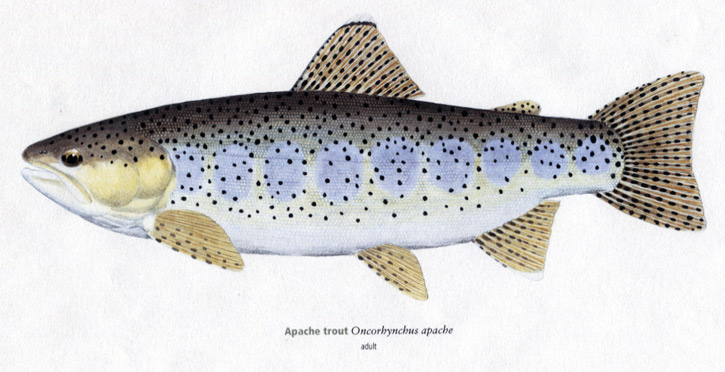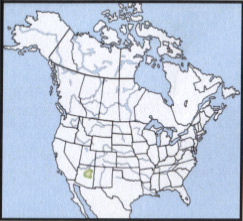Apache Trout, June 2011, Fish of the Month!
 Apache Trout
Apache Trout
Oncorhynchus apache
Local Names:
Arizona Trout
Average Size:
8 to 10 inches
typically less than 1 pound
Distinguishing Field Marks:
The dorsal fin of the Apache trout are unusually large in relation to its body size. Because it usually does not grow large, this trout its "parr marks" (pale oval patches along the lateral line) throughout its life.
North American Range:
Map to the right shows approximate range in North America.
Diet:
Stream-dwelling Apache trout consume a diet nearly entirely of immature and adult stages of aquatic insects. In lakes they are more opportunistic in their feeding, ranging throughout the water column, and taking aquatic insects, leeches, crustaceans, and small fish.
Fly Fishing for Apache Trout:
Once again I imagine some (many?) of you wondering, “Why is this Thompson guy telling us about a fish most of us will never see?” The answer to that is a bit complicated. Mostly it is that this American native trout is now in “come-back” mode, coming back from the brink of near extirpation. This near fatal reduction in the species’ numbers was primarily the result of “sportsmen” who knew where these fish lived and had easy access to them, doing what the majority of “sportsmen” did/do when encountering an apparent abundance of any fish population, they “took their limit” as many (and probably more) times as they could. Same as Striped bass, Atlantic salmon, Bluefin tuna, Blueback trout, Bull trout, the Pacific salmons, Steelhead etc., etc. The end result of over-fishing any species is now a very well documented 20th and 21st century phenomenon. What you wind up with is too few fish to make commercial, and concurrently or eventually, sport fishing viable. Atlantic Canada has been losing its runs of large Atlantic salmon for several decades now. You can understand how a regional economy based on “plenty of fish” can suffer when those fish are all but, or even entirely (as is the case in many Maritime rivers) gone.
Because its range is quite limited and generally rather inaccessible, the economies of this trout’s native region haven’t been that deeply effected by its decline (after all, it is a rather small trout). Nevertheless, the removal, or addition, of any species has both researched and unknown effects on its environment. Large amounts of both $s and human research and effort have gone into the restoration of the Apache trout. So this “little guy” is here included as an “indicator” species; indicating how far we have (or have not) come in our understanding and appreciation of the dwindling “natural resources” of the once vast North American continent.
As you can see, the Apache trout is found within a limited range in the U.S. Most will be found in the shallower sections of upland tributary streams where they will take imitations of any stage of whatever aquatic insects are most readily available to them at the time you’re fishing. There’s no need to tell any of you seasoned fly-fishers that a fish that rarely exceeds 10 inches in length is best approached with no more than a system 4 outfit, often set up with a long light-tippeted leader. In lakes where this trout is found, you might want either a long (10 foot) system 4 or somewhat heavier (5 or 6 wt. 9’) outfit for the purpose of casting small streamers to appeal to the Apache’s inclination to take larger foods when living in a larger body of water.
In any case, be sure to read and understand all the state and local regulations that apply to angling for this elegant little, slowly, and with lots of human TLC, coming-back-into-its-own, trout before you go thrashing around in its home waters hell-bent on filling your camp-site’s wood-heated cast iron fry pan with butter basted Apache trout. Should you ignore this advice and keep to the trout-for-the-pot way of outdoor life, you may find yourself relived of your catch, your fishing license, fishing tackle, and perhaps even your SUV, should a conservation officer find your behavior a little outside of the law.
Bottom line? It’s up to us to do whatever we can to help protect and conserve what’s left of what was once seemingly endless bounty living in our American woods and waters.






